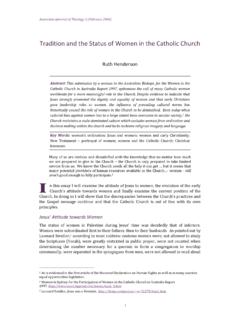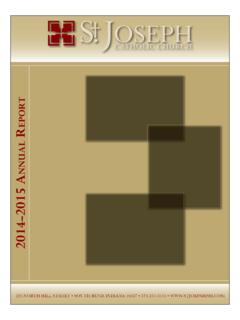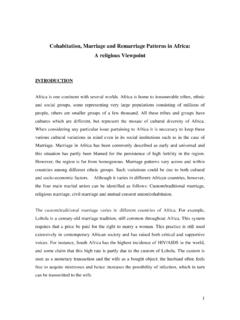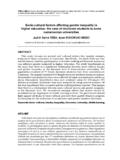Transcription of Role of Gender Equality in Development - A …
1 Mmf fls afa sflassflassflasfffffffffffffffffffffffff fffffffffffDiscussion PapersRole of Gender Equality in Development A Literature ReviewAnne MikkolaUniversity of Helsinki, RUESG and HECERD iscussion Paper No. 84 November 2005 ISSN 1795-0562 HECER Helsinki Center of Economic Research, Box 17 (Arkadiankatu 7), FI-00014 University of Helsinki, FINLAND, Tel +358-9-191-28780, Fax Paper of Gender Equality in Development A Literature Review *AbstractTo get a sense of the role that Gender Equality plays in the process of Development andgrowth, diverse literature is reviewed from microeconomics and macroeconomics anddeveloping and developed country perspective. Some global stylized facts are reportedand both empirical and theoretical results are surveyed. Women s roles are found to be ina process of a global change. These changes may stem from changes in technology asthe industrialization has made the extensive home-based production obsolete and reducedthe demand for children as an input for this production.
2 Instead of the genderedspecialization in autarkic households, the modern specialization in the market place mayhave led to lower fertility and the changing roles of women in the economies. Adjustmentto these changes poses challenges globally as the old hierarchical Gender valuations stillappear in many different disguises. Overall the literature gives hints as to what the issuesin Gender inequality are that seem to be associated with the overall level of economicdevelopment: values and religion, cultural restrictions and roles, legal and inheritance lawsand practices, the marital pattern of resource allocation, monogamy vs. polygyny, labormarket access, education, fertility, Gender specific market failures in finance, power in thepolitical decision Classification: O10, J16, J71, D63 Keywords: Gender Equality , Development , women, segregation, stylized MikkolaDepartment of Box 17 (Arkadiankatu 7)University of HelsinkiFI-00014 University of want to thank Anna-Leena Asikainen, Basudeb Guha-Khasnobis, Pertti Haaparanta, Marja-Liisa Halko,Seppo Honkapohja, Vesa Kanniainen, Erkki Koskela, Biing-Shen Kuo, Ulla Lehmijoki, Heikki Loikkanen,Carrie A Miles and Maiju Per l who have read through versions of this manuscript, given suggestions,made me aware of strands of literature, challenged my thinking and/or have been an encouragement alongthe way.
3 The comments of the participants of the HECER Lunch Seminar, 2005, Nordic Conference onDevelopment Studies in G teborg, 2004, Kansantaloustieteenp iv t, 2004, the DEVESTU Seminar onPolitical economy of aid and poverty in Kellokoski, 2004, and the Women Economists Meeting, 2003 areappreciated. 31 Introduction How might Gender Equality affect growth and Development ? Typically, women have globallyless economic opportunities to improve their lives. They are often restricted in terms ofeducation, the ownership of wealth, monetary return for their work, financial opportunities, andopportunities to influence the decision making at the level of the family and the society. Giventhat women are about half of the population and economic potential, it is likely that this situationshows at the macroeconomic level as well. Casual observation indicates that countries in whichwomen and men have more equal economic opportunities are also the more affluent seems to be some association between level of Development and the role of women in thesociety.
4 As women s status is considered one of the top priorities in Development (see UNmillennium Development goals) research in this field is less attention is paid to men s issues. Jacobsen (2002) points out the importance fordevelopment of addressing the specific disadvantages that men face. Much like in women s casethere are global problem areas for men, in both developing and developed countries. She reportsdata on the destruction of human capital that affects men more than women and points out howthe changing roles of men put new demands on them. Even if men s restrictions are perhapsmore of a self-imposed nature they should be paid attention to and targeted by policy may be little hope of ultimately addressing women s issues if the men are ignored. As thispaper proceeds to review the literature on Gender Equality mostly focusing on women, it is usefulto keep in mind the issues where Gender biases show destructively in men s the level of macroeconomics, it has been quite difficult to show effects of the status of womenon aggregate growth for econometric reasons among others.
5 However, there is moremicroeconomics literature that might help in understanding how the economic Development andgrowth might be affected by direct or indirect restrictions or exclusion that women have adjustedto. This is a relevant question particularly in the developing countries. Easterly (2001) arguesthat the continual failures of the western organizations to help the developing countries towardsdevelopment have been due to the failure to account for the incentives people face. Women inparticular face different incentives than men do. Those in the grass root Development workgenerally acknowledge the importance of the status of women in Development . The UnitedNations Millennium Development Goals for example include Gender issues among the top 4priorities. United Nations Development Program (UNDP) and the World Bank have also doneextensive research on Gender and speaking there is a difference between the theoretical and empirical modelingstrategies when it comes to the role of Gender .
6 Standard economic theories in public choiceor welfare economics do not focus on individual characteristics. The individual actor in welfareeconomics could equally well be a world citizen, a country national, a man or a woman. As aconsequence these theories can be of limited help to policymakers, who are often particularlyconcerned about the effects of income redistribution on different groups of people, like mothers,single households, families, etc. However, when the welfare economist, public choice economistor labor economist does empirical work, he or she is forced to consider Gender as women sbehavior differs from that of men to the extent that a single explanatory model is clearly oftennot applicable. For example, one may estimate party approval rates separately for men andwomen, or at the minimum one is forced to add a Gender dummy to account for the women are considered separately from men as an empirical necessity rather than issuesrelating to women being the primary concern.
7 An example of this is seen in the empirical growthstudies by Robert Barro, where the effect of female and male education on growth showdifferently and in a puzzling this split between the theoretical and empirical practice one might ask what has lead tothis situation and if it really is that important to be aware of the Gender distinction when thinkingabout the macro level issues. Some insights come from the feminist economics tradition that isdiscussed in the book edited by Ferber and Nelson (2003). Feminist economists have looked intothe common assumptions in economics that are associated with the invisibility of Gender and theresulting Gender bias in the field. Blank and Reimers (2003) point out that the economists haveoften been ignorant on the results of other social sciences. For instance, the social norms andbehaviors that come from belonging to a particular community tend to be left aside by treatingpreferences and tastes as given and unchanging.
8 History, however, shows that the institutions andsocial norms have changed over time and so have the constraints facing women. Psychology,sociology, and anthropology give insights on how the preferences, tastes and desires are standard method in economics of focusing on choices under given tastes and constraintstends to take the status quo concerning the constraints and tastes as a permanent situation as faras the analysis goes. Economists also tend to emphasize efficiency at the cost of equity as theinterpersonal utility comparisons are shied away from. Yet, if we consider women s status as 5important we would need to precisely identify the constraints for women and then study howloosening them would affect the economic choices and equity and thereby Development at themacro level. England and Folbre (2003) also point out the lack of consideration in economics forcare, which is an important part of women s lives and of any society and its our stance is on feminist economics, we need to be aware of these issues whenanalyzing the effect of Gender on Development at the macro level.
9 Indeed, some of the morerecent fields of study in economics, like behavioral economics, take some of these challengesmore seriously. Another example of risen awareness of the need to consider changing socialnorms and culture is a recent book on economics growth by David Weil (2005), which givesconsiderable emphasis on culture and paper reviews some of the diverse literature that touches the role of Gender in the economy,with the specific focus on issues, which might be expected to be the most critical for strategy in the paper is to look at the evidence, data, issues and analysis in theliterature covering both the developed world and the less developed world. There is a wide rangeof differences both in women s status and roles across countries. Likewise, there is a wide rangeof differences in the level of economic welfare across countries. In some cases, we can also lookat how the country s economic Development over time is associated with changes in the role ofher women.
10 In reviewing the literature, attention is paid to locate where the Gender surfaces theeconomic sphere. Both empirical and theoretical research touching these issues has been done inseveral areas of economics such as labor economics, family economics, studies on growth, Development economics and political economics. 62 Stylized facts on Gender Equality A historical perspectiveWhen we are talking about women s relatively lower status today, it is useful to remindourselves of how today s world looks like from the historical perspective. Lagerl f (2003)suggests that the reason why the economic Development spurted in Europe had to do withchanges in Gender Equality over the past 2000 years. These changes were possibly initiated bythe spread of Christianity. As opposed to the Greco-Roman world, the early Christians improvedthe status of widows allowing them to keep her husband s estate and extended women s rights toinherit and hold property.







